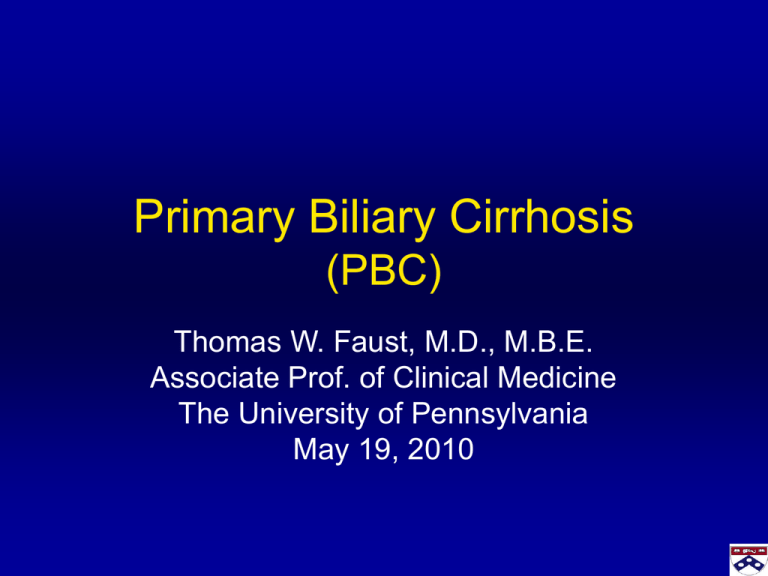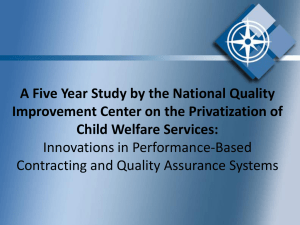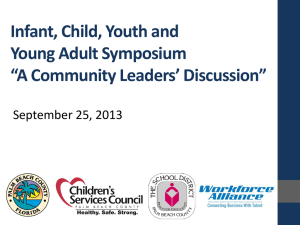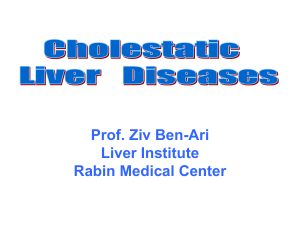Primary Biliary Cirrhosis (PBC) - University of Pennsylvania School
advertisement

Primary Biliary Cirrhosis (PBC) Thomas W. Faust, M.D., M.B.E. Associate Prof. of Clinical Medicine The University of Pennsylvania May 19, 2010 PBC Overview Introduction Epidemiology Genetics Pathogenesis Clinical presentation Extrahepatic manifestations Differential diagnosis Diagnosis Management – Medical – Surgical Complications – Portal hypertension – Cholestasis Natural history and prognosis Summary PBC Introduction Chronic cholestatic liver disease Autoimmune basis Middle-aged females Disease of small bile ducts – Cirrhosis with portal hypertension – Complications of cholestasis Diagnosis – Liver function tests – Antimitochondrial antibodies (AMA) – Histology UDCA for all patients Transplantation – Marginal liver reserve – Poor quality of life – Prognostic models PBC Epidemiology Female:male ratio of 9:1 Most common during middle age Presentation similar between genders, races, and sexes Prevalence: 19-150 cases/million Incidence: 4-15 cases/million/yr Incidence/prevalence rates increasing? Familial clustering Kaplan et al. NEJM 2005;353(12):1261 PBC Genetics MHC class II – DR8, DQA1*0102, and DQ/1*0402 MHC class III – C4 null, and c4B2 Non-MHC genes – Exon 1 of CTLA-4 Increased familial risk – PBC/positive AMA and impaired T-cell regulation – Extrahepatic autoimmune diseases PBC Pathogenesis A model autoimmune disease Genetic susceptibility plus triggering event AMA titer – – – – No correlation with disease severity No difference in AMA (+) and (-) disease Role in pathogenesis? Reactive against E2 subunit of pyruvate dehydrogenase Antigen expression – Inner mitochondrial membrane – Luminal surface of biliary epithelial cell – Interlobular and septal bile ducts Apoptosis – Cholangiocyte Fas receptor expression Cholestasis James et al. Ann. Intern Med 1983;99(4):500 Selmi et al. Gastroenterology 2004;127(2):485 PBC Pathogenesis Antigens on inner mitochondrial membrane – Oxoacid dehydrogenase complex – Autoreactivity to E2 subunit of this complex Molecular mimicry – Bacterial or viral proteins, or halogenated hydrocarbons similar to E2 subunit? – Immune attack of biliary epithelial cells • CD4 and CD8 T lymphocytes • Aberrantly expressed antigens – Antigens similar to E2 subunit exposed after contact with exogenous xenobiotics that damage biliary epithelial cells – MHC class II and I antigen restriction and T cell interactions Gershwin et al. Hepatology 2005;42(5):1194 Selmi et al. Gastroenterology 2004;127(2):493 Kaplan et al. NEJM 2005;353:1261 PBC Asymptomatic Disease 50-60% of patients (earlier diagnosis) 36-89% of asymptomatic patients develop symptoms within 4.5-17 years Elevated AMA Liver biopsy C/W PBC Liver chemistry tests – Normal – Cholestatic 50-70% 10 year survival in asymptomatic patients and median survival of 5-8 years from onset of symptoms (pre-UDCA era) UDCA associated with better survival when compared to pre-UDCA era Balasubramaniam et al. Gastroenterology 1990;98(6):1567 PBC Symptomatic Disease Fatigue (common) Pruritus Jaundice Hepatosplenomegaly RUQ pain Hyperpigmentation Koulentaki et al. Am J Gastroenterol 2006;101(3):541 Xanthomas and xanthelasmas Dyslipidemia Extrahepatic autoimmune diseases Complications – Portal hypertension – Chronic cholestasis PBC Complications Chronic cholestasis – Osteopenia – Malabsorption – Steatorrhea • Bile salt deficiency • Pancreatic disease • Celiac disease – Vitamin A, D, E, K deficiency Portal hypertension – Esophageal and gastric varices – Ascites – Encephalopathy – SBP – HRS or HPS – Hepatocellular carcinoma PBC Portal Hypertension HCC Ascites Varices PBC Metabolic Bone Disease Osteoporosis – Most common – Duration/severity of PBC and jaundice – Axial skeleton – Reduced osteoblastic activity – DEXA scanning – Calcium, vitamin D, and bisphosphonates? – Estrogens? Osteomalacia – Less common – Vitamin D deficiency and fat malabsorption – Calcium and phosphate levels – 25-hydroxyvitamin D level – Calcium and vitamin D supplements PBC Metabolic Bone Disease Compression fractures PBC Dyslipidemia Early disease – Increased HDL, LDL, and VLDL Late disease – Fall in HDL and rise in LDL Xanthomas and xanthelasmas – Cholesterol > 600 mg/dL Atherosclerosis risk – No increased risk of ischemia heart disease, stroke or TIA unless there is a separate lipid disorder PBC Dyslipidemia Xanthelasmas Xanthomas Xanthomas Xanthomas PBC Associated Diseases Thyroid disease – Hashimoto’s thyroiditis – Grave’s disease Scleroderma CREST syndrome Sjogren’s syndrome Arthritis Raynaud’s phenomenon Celiac disease Renal tubular acidosis – Proximal – Distal Gallstones Hematologic disorders Inflammatory bowel disease (rare) Pulmonary interstitial fibrosis (rare) PBC Crest Syndrome Calcinosis Sclerodactyly Raynauds Telangiectasia PBC Differential Diagnosis Biliary stones or strictures Pancreaticobiliary malignancies PSC Autoimmune hepatitis Alcoholic hepatitis Viral hepatitis Sarcoidosis Autoimmune cholangiopathy Medications Granulomatous hepatitis PBC Non-Invasive Tests Biochemical tests – – – – – – – – – Alkaline phosphatase GGT 5’ nucleotidase AST and ALT Bilirubin Total cholesterol Serum IgM Prothrombin time Albumin Dickson et al. Hepatology 1989;10(1):1 Muratori et al. Clin Liver Dis 2008;12(2):261 Kaplan et al. N Engl J Med 2005;353(12):1261 Serology – – – – – AMA (95%) ANA (50%) ASMA (50%) Anti-centromere Anti-thyroid Medical imaging – Ultrasound – CT – MR or MRCP PBC Histology Stage I (portal) – Inflammation of interlobular and septal bile ducts – Granulomatous (florid duct) lesion Stage II (periportal) – Inflammation of interlobular and septal bile ducts – Ductular proliferation Scheuer et al. Mayo Clin Proc 1998;73(2):179 Stage III (septal) – Inflammation of interlobular and septal bile ducts – Fibrosis – Bile duct loss – Cholestasis Stage IV (cirrhotic) – Established cirrhosis PBC Pathology Cirrhosis NRH PBC Overall Management Survival of patients with PBC inferior to that of a healthy control population Medical or surgical treatment warranted in all patients No medical therapy has been shown to conclusively alter the history of PBC Goals of treatment – Slow disease progression – Treat complications PBC Medical Management PBC: an autoimmune disease Improve clinical symptoms and signs of disease Improve liver function tests Reduce or eliminate bile duct injury Improve patient survival free of transplantation PBC Medical Management Ineffective – – – – – – Corticosteroids Azathioprine Cyclosporine Penicillamine Colchicine Chlorambucil Possibly effective – Methotrexate – Mycophenolate mofetil Effective – Ursodeoxycholic acid • Improvement in symptoms • Improvement in LFTs • Improvement in histology • Improvement in transplant free survival Combination therapy? – Additional studies warranted PBC UDCA Effective dose: 13-15 mg/kg/day indefinitely Mechanism of action – – – – – Promotes endogenous bile acid secretion Replacement of hepatotoxic (endogenous) bile acids Stabilizes biliary epithelial cell membranes Alters HLA I-II expression on biliary epithelial cell Inhibits biliary cell apoptosis Improvement in LFTs Delays disease progression and improves transplantfree survival Follow LFTs every 3-6 mo. Poupon et al. N Engl J Med. 1994;330(19):1342 Heathcote et al. Hepatology 1994;19(5):1149 PBC Incomplete Responders to UDCA 66% of patients Definition – Failure to normalize LFTs – Development of cirrhosis on therapy Predictors of incomplete response – High alkaline phosphatase or GGT – Advanced disease prior to UDCA initiation Assess: patient compliance, UDCA dose, overlap syndrome Combes et al. Hepatology 1995;22(3):759 Poupon et al. J Hepatolol 2003;39(1):12 PBC Methotrexate Dose: 7.5-15 mg/week orally Improvement – Symptoms – LFTs – Histology? – Survival? Side effects limit long-term use PBC Combination Therapies UDCA and corticosteroids – Improvement in LFTs – Variable improvement in histology UDCA and colchicine – No significant benefit UDCA and methotrexate – Improvement in LFTs ? – Additional studies warranted PBC Novel Agents Malotilate – Improvement in LFTs – No improvement in survival Bezafibrate – Improvement in LFTs Thalidomide – No improvement in LFTs – No improvement in histology PBC Liver Transplantation Advanced PBC with marginal reserve Portal hypertension – Refractory variceal bleeding – Intractable ascites – Intractable encephalopathy – SBP – HRS or HPS Lee et al. Clin Gastroenterol Hepatol 2007;5(11):1313 Dickson et al. Hepatology 1989;10(1):1 Chronic cholestasis – Intractable pruritus – Metabolic bone disease and fractures – Malabsorption – Vitamin deficiency Hepatocellular Cancer Transplant options – Cadaveric donation – Live donation PBC Liver Transplantation Patient and graft survival – 1 yr : 83-92% – 5 yr : 75-85% Higher risk of rejection PBC recurrence – – – – – – 15 to 25% of patients at 10 years Granulomatous bile duct injury AMA does not define recurrence Exclude other post transplant disorders Intermediate term patient and graft survival are good Use of UDCA for recurrent disease uncertain Liermann et al. Hepatology 2001;33(1):22 PBC Complications of Portal Hypertension Variceal bleeding – Endoscopic screening – Non-selective beta blockers – Endoscopic therapy • Sclerotherapy • Band ligation – Surgical shunts – TIPS HCC – AFP/imaging Ascites – Sodium restricted diets – Diuretics – Therapeutic paracentesis – TIPS Encephalopathy – – – – Lactulose Neomycin Rifaxamin Protein modification PBC Metabolic Bone Disease 30-50% of patients Classification – Osteoporosis: common – Osteomalacia: rare Bone density – Below fracture threshold (33%) Diagnosis and F/U – DEXA scan – Every 1-2 yrs Management – Calcium and vitamin D – Adequate exercise – Estrogen replacement • Post menopausal – Other medications • Alendronate • Etidronate – Transplantation • Progressive disease PBC Treatment of Metabolic Bone Disease Calcium – 1000-1500 mg/d Vitamin D – 800-1000 IU (normal 25-OH vitamin D level) – 50,000 IU vitamin D2, 2-3 times weekly if 25-OH vitamin D level is low) then maintenance Bisphosphonates – Alendronate 70 mg weekly – Data lacking regarding efficacy Estrogens – Not first line because of complications PBC Pruritus Antihistamines – 50% response rate Cholestyramine – 90% response rate Phenobarbital – Somewhat beneficial – Sedative side effects UDCA – Inconsistent results Rifampin – Rapid onset of action – Can cause liver injury Other medications – Opiate antagonists – Sertraline – Ondansetron? Other – Extracorporeal support – OLT PBC Vitamin Deficiency Vitamin A – 20% of patients – Night blindness – Replace as appropriate – Can cause liver injury Vitamin D – Replace as appropriate – Can cause liver injury – Supplemental calcium Vitamin E – Rarely seen in adults – Neurologic sequelae • Reduced proprioception • Ataxia – Replace as appropriate Vitamin K – Risk of hemorrhage – Replace as appropriate PBC Hypercholesterolemia Elevated cholesterol: 85% of patients Stage I or II disease: increased HDL predominates Stage III or IV disease: increased LDL No increased risk for ischemic heart disease Lipid-lowering drugs not recommended unless there is a separate lipid disorder Plasmapheresis for xanthomatous neuropathy and symptomatic planar xanthomas PBC Steatorrhea Causes – Reduced bile delivery to intestine – Coexisting pancreatic insufficiency – Coexisting celiac disease – Coexisting bacterial overgrowth Management – Reduced bile delivery • Low fat diet • Medium chain triglycerides – Pancreatic disease • Pancreatic enzymes – Celiac disease • Gluten-free diet – Bacterial overgrowth • Antibiotics PBC Preventive Care Avoid excess ETOH, obesity, smoking Monitor thyroid function annually EGD every 1-3 years DEXA every 1-4 years Fat soluble vitamin assessment every 1-3 years depending upon liver function AFP and cross sectional imaging in patients with cirrhosis Lindor et al. Hepatology 2009;50(1):291 PBC Natural History and Prognosis PBC progresses over 15-20 yrs Median survival – Asymptomatic disease: 10-16 yrs – Symptomatic disease: 7.5-10 yrs – Bili. (8-10 mg/dL): 2 yrs 40-100% of asymptomatic patients develop symptoms within 2-4 yrs PBC Prognostic Models Benefits – Predicting survival without transplantation – Determining need for transplant evaluation – Assessing effectiveness of medical therapies Mayo model – Age, total bilirubin, albumin, PT, and volume overload – Bilirubin: most important variable – Doesn’t take into account intercurrent events • Variceal hemorrhage, liver cancer, quality of life Dickson et al. Hepatology 1989;10(1):1 Murtaugh et al. Hepatology 1994;20(1 Pt 1):126 PBC Summary Important cause of chronic cholestatic liver disease Middle-aged females predominate Immune pathogenesis favored Other autoimmune diseases frequently coexist PBC progresses in most patients PBC Summary Complications of portal hypertension and chronic cholestasis associated with progressive disease UDCA is standard medical therapy for all patients Transplantation reserved for patients with marginal liver reserve and complications Prognostic models predict disease severity and need for transplantation






